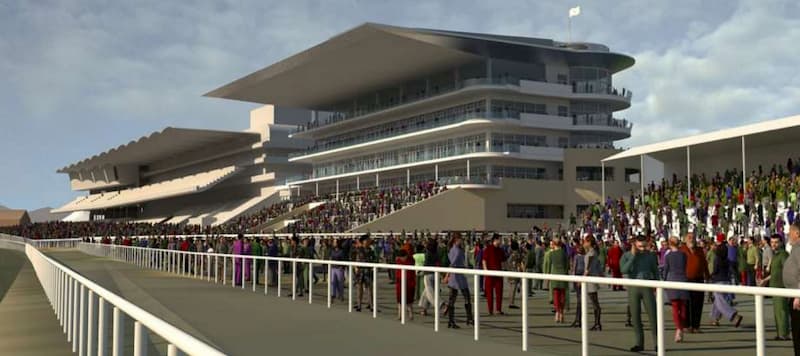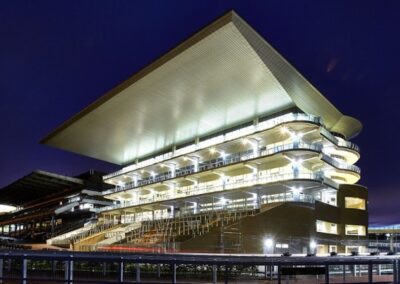Project Overview
The re-development of Cheltenham Racecourse was a complex scheme which presented numerous challenges, including a capped project cost, short programme, connection to existing buildings and the logistical issues presented by programming the works around a calendar of events and day-to-day operations.
The dramatic new complex, with the Princess Royal Grandstand and Crescent Walkway at its heart, provided a quality fivestar new build and refurbished facilities which were delivered to the complete satisfaction of the client. The project required management of an extended construction team and supply chain in order to safely deliver value for money, fit for purpose, high quality facilities and a reduction in environmental impact both in construction and operation.

Best Practice
Leadership: The lead project manager, Paul Fowles, demonstrated outstanding leadership throughout the project. For example, only 3 weeks before the first race of the season in October 2014, 50% of the racecourse was a construction site, and 30% needed to be in play before the event. He achieved completion of this by reassuring the client with precisely detailed plans, and motivating a committed workforce to focus on making their working areas immaculate.
Collaboration: By maintaining total integration with the supply chain and subcontractors, the project manager encouraged a more collaborative way of working. Regular workshops ensured that ideas and inspiration were shared and best practice encouraged, delivering better value for the client.
Meeting the programme: Through close collaboration with all parties, the project team achieved the opening of the grandstand two months earlier than planned. The final account was agreed before handover, which is an exceptional achievement for a project of this size.
To maintain programme and reduce cost of excessive safety equipment, the balustrades were fitted to the pre-cast balcony units at ground level rather than 80ft in the air. The finished design then provided edge protection for continuing the façade.
Integration of design: The project manager collaborated with the architect and subcontractors at design stage to reduce operations and achieve quality, cost and programme targets. Continuity of design was ensured, for example, through meeting with the client’s catering design to ensure FF&E design was fully integrated with the overall project.
Regular inspection of the design detail ensured optimum build quality. For example, the roof design and detailing of the cladding on the grandstand was subject to high level interest due to significant wind loads at Cheltenham and safety issues the client had on another project. Roofing contractors were brought in early so that the client and project manager could select the right project and contractor. Extensive reviews were carried out during its installation to ensure that minimum standards were exceeded.
Sustainability: The client was awarded the Gloucestershire Green Business award during construction of the project to reflect its achievements in providing long term sustainability.
Added Value
Dedication to the vision of the project: The project manager stayed on call 24/7 to address any unexpected incidents on racedays, and was awarded a Jockey Club Core values in Action Award for his efforts. An insistence that the team would achieve the contractual dates against challenging circumstances ensured that the project was delivered before the deadline.
Innovative solutions: Innovative solutions to logistical challenges were offered, for example, piling the foundations for the Crescent walkway, the final phase, the year before. This was an effective solution that avoided having to work in accessible areas later on.



